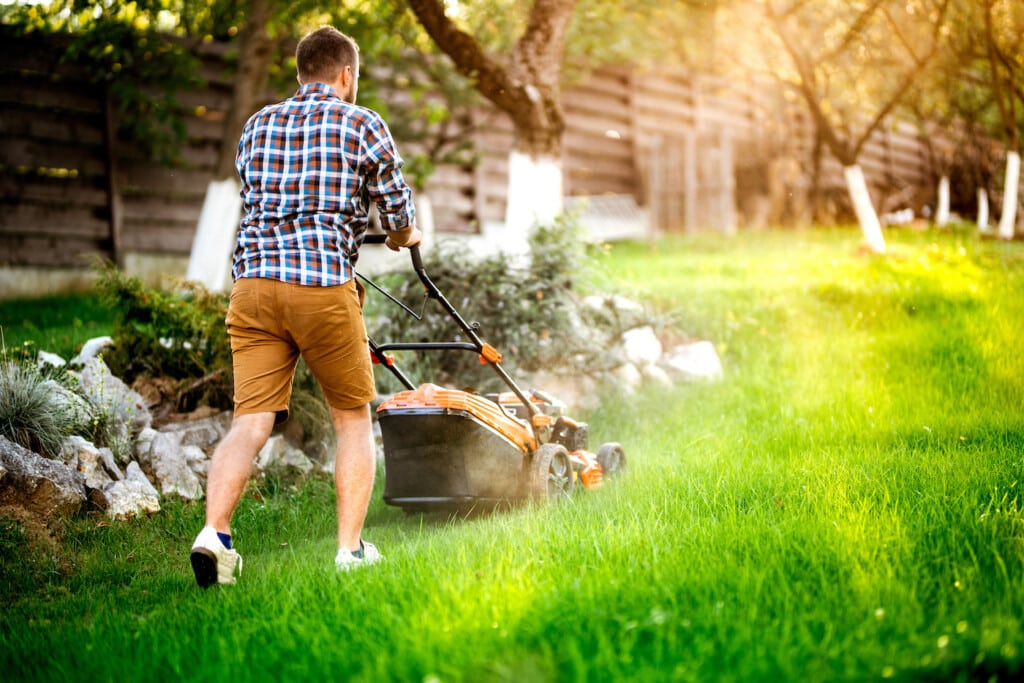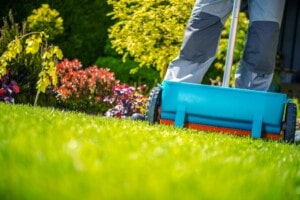
With spring here and a long, cold winter finally behind us, it is time to give your lawn a little love in preparation for summer. To have the best possible summer lawn, you should get started now. Here are some tips to improve your lawn this spring.
Thatch is a mix of partially decomposed leaves, stems, and grass roots that accumulates between the vegetation and the soil. There is some debate over whether dethatching is helpful or harmful. A thin layer of thatch holds water and protects the soil from rapid temperature change, but too much can make your lawn more susceptible to lawn diseases, reduce its tolerance to drought, and inhibit the movement of nutrients and fertilizers in the soil.
Provided the level of thatch is no more than 1/2, you can simply rake deeply to clean away grass blades that died in the winter and which might block new growth. Wait for the grass to green up, indicating that it is well-rooted and then use a flexible leaf rake to avoid causing damage.
If your lawn gets a lot of foot traffic from kids playing, for example, it suffers from soil compaction. Moss thrives on compacted soil, so this is a good indicator. If your lawn is suffering only a mild amount of compaction, you may be able to simply poke holes here and there in the soil, but for more severe cases, an aerator will break up the compacted soil, allowing water and fertilizer to reach the roots.
An aerator pulls plugs out of your soil. This will loosen up compacted soil and allows air and water to reach the roots. Aerating is considered a better way to dethatch your lawn since it puts less stress on it.
To grow well, your lawn will need proper soil which is neither acidic nor alkaline. While you can purchase products to adjust the pH, you will first need to know what is needed. Your local garden store should sell soil test kits that will give you an idea where to start.

Weeds are a source of frustration for many. If you don’t take steps early on to control them, then you may be fighting them—and probably losing—all summer. Several methods exist to prevent them before they sprout, including alternative treatments that do not contain harmful chemicals.
Have bare patches in your lawn? Planting grass seed can fill it in but be aware that these newly seeded areas will need extra care (watering, weeding) throughout the summer and will probably need to be seeded again come fall. Rake the loose grass off and fill in the patch with topsoil. Rake in some grass seed and keep it moist.
If larger areas need attention, spring is a good time to lay sod. Remove the old grass and a bit of the old soil. Prepare the area with a garden rake to level the soil and break up a large chunk of soil before you lay the sod. Be sure to water frequently.
It is important to try different types of grass and seeds because some are more durable, while other types require varying amounts of sunshine and shade.
Wester Turf Farms carries five different varieties of grass seeds.
You can fertilize your lawn organically by topdressing with compost. Alternately, a mulching mower will chop up your lawn clippings, creating a nourishing source of nitrogen. Aim to do this toward the end of spring, as too much fertilizer too early means mowing sooner and encourages weeds.

Lawn fertilizers are classified by the N-P-K numbers on the label. These letters stand for Nitrogen (N), Phosphorus (P) and Potassium (K) and represent the percentage by weight of each of those nutrients in the fertilizer. Nitrogen rich fertilizers help plants grow and green up, Phosphorus improves deep root development and Potassium is essential for all around health and disease/drought resistance. If you’re looking for a fertilizer that is ideal for applying to new sod to enhance root growth, or you are looking to maintain a balance of nutrients to help your lawn thrive throughout the year, take a look at these fertilizers.
We’d recommend fertilizing your lawn every 6-8 weeks, as when it grows and gets cut, the nutrients in the soil deplete and need to be replenished. We would suggest you fertilize your lawn once in early spring, once in late spring, once in late summer and finally in the fall, just before the snow comes. This will encourage a thick healthy lawn and reduce the chance of weeds.
This is a good time to inspect your tools. Is your hose in good shape? Take your mower in for service, or give it a tune-up by changing the oil, replacing the air filter, and changing the spark plugs, or if electric, check the power cord for damage.
Having a lush green lawn this summer is possible, but you should take steps now to make it a reality. A bit of preparation in the spring can give you a lawn to enjoy through the rest of the year.
Order fresh sod now or request a custom quote for your project.
Save with a Yearly membership. Custom fertilizer program. Fertilizer, topsoil, seed delivered to your door before you need it. Don’t forget, we will remember for you!
Western Turf Farms Abbotsford
39183 No.5 Road Abbotsford, BC V3G 2G3
Western Turf Farms Langley
7880 240 Street Langley, BC V1M 3P9
© Copyright 2025, all rights reserved by Western Turf Farms. By using our website you agree to our Disclaimer and Privacy Policy.